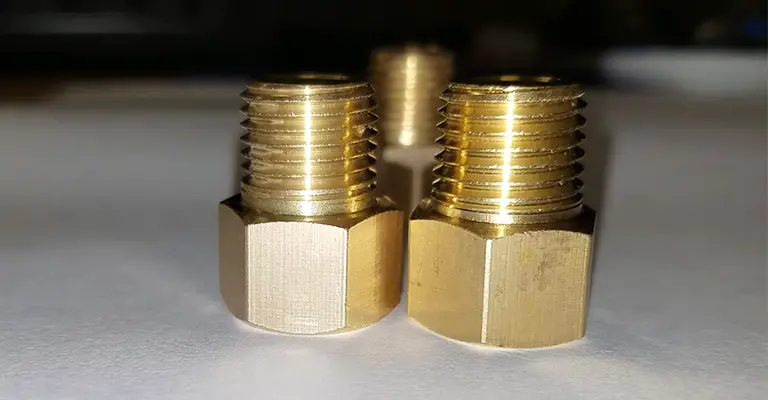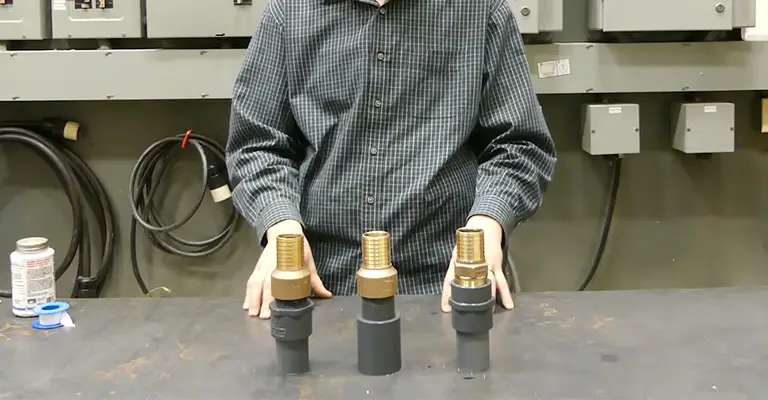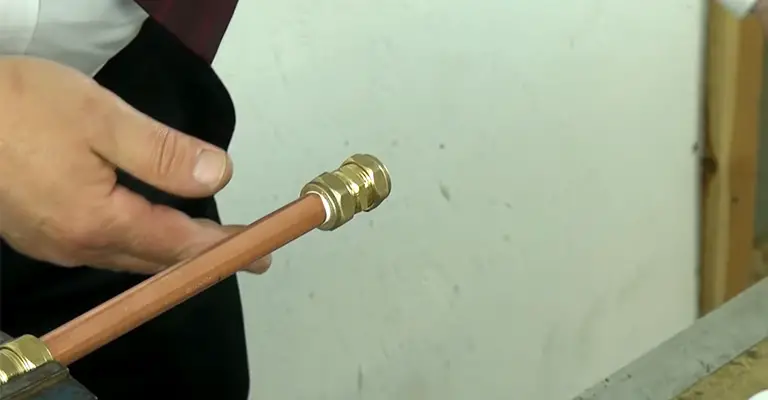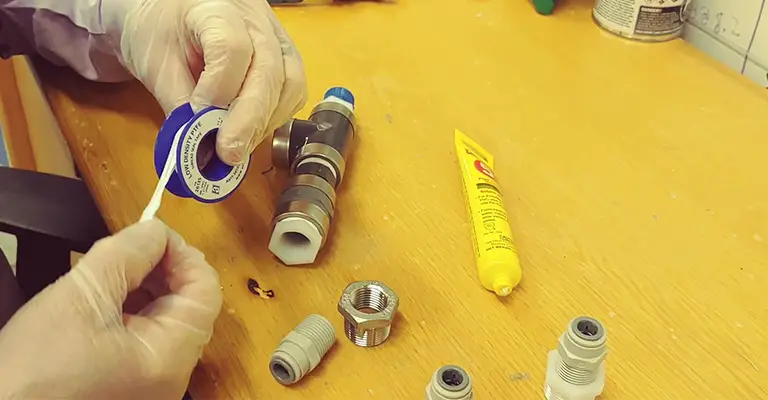Threaded fittings are crucial in plumbing and piping systems as they provide a secure connection between pipes and fittings.
There are several types of threaded fittings, but two of the most commonly used are IPS (Iron Pipe Size) and NPT (National Pipe Taper) threads.
Both of these threads have their own unique features and are used for different purposes. Understanding the differences between IPS and NPT threads is important to ensure a secure and leak-free connection in your piping system.
This article will provide an overview of IPS and NPT threads and highlight their key differences. IPS stands for Iron Pipe Size and refers to a standardized system of measuring pipes and fittings used in the United States.
IPS threads are tapered, so they get wider gradually toward the end. This helps create a tight seal between the male and female threads. IPS threads are typically used in older homes and buildings.
NPT stands for National Pipe Taper and refers to a standardized system of measuring pipes and fittings used in the United States.
NPT threads are also tapered and are designed to create a tight seal between the male and female threads. Unlike IPS threads, NPT threads have a constant pitch, meaning the distance between threads is consistent along the length of the pipe.
NPT threads are commonly used in newer homes and buildings and are more versatile than IPS threads as they can be used with various types of materials.
It is important to note that IPS and NPT threads are not interchangeable, so using the correct type of thread for your piping system is crucial.
IPS & NPT Threads Explained

IPS is meant to seal on washers, similar to the threads attached to hoses, faucets, and toilets. Tapered threads such as NPT are designed to seal on the threads, which is why pipe tape is used to lubricate the threads, help them deform, and create a seal.
The two types of connections, IPS and NPT, are often confused but are not interchangeable. Yes, there are some similarities between them. Although the names are similar, you can tell the difference just by looking at them.
What Is An IPS Pipe Connection?
A connection called an IPS (Iron Pipe Size) has existed since the nineteenth century. As a result, it’s an older system. The thickness of the pipe walls determines the iron pipe size or IPS.
Pipes made of wrought iron were originally sized using IPS pipes. There are still iron, steel, brass, and PVC plumbing parts that use the connection standard, even though it’s backdated.
There is a certain amount of confusion for DIYers when it comes to understanding this critical difference.
As a result of the naming structure, this is the case. On plumbing fittings, you can often find threads with FIPS or MIPS. The IPS system is used to create this threading.
It is a common misconception that the IPS connection is only available for threaded fittings. As a result, it’s best suited to iron pipes (since they are threaded).
However, that isn’t the case. This type of connection can be found in many PVCs. It begs the question, why?
According to the IPS standard, the pipe’s outer dimensions are considered. This type of connection is most suitable for household connections, such as underground piping systems. It is similar to the size of steel pipe on the outside of a standard PVC.
Where To Use The Ips Pipe Connection?

The connection between an IPS pipe and an NPT pipe can be made using an IPS pipe connection. An IPS pipe needs to be threaded with NPT threads.
Both parts will fit together if you have an IPS or NPT connector. In what situations should IPS fittings be used?
To understand its performance characteristics, we need to examine its prominent features. A study found that IPS pipes have low thermal conductivity and power consumption. For this reason, hydronic heating systems work best with them.
A hot water system using IPS pipe threads can quickly reduce heat loss. As well as offering extended service life, IPS pipes are lightweight and durable. The importance of such connections cannot be overstated.
What Is An NPT Pipe Connection?

An NPT is an acronym for National Pipe Tapered Thread. As well as ANSI/ASME B1.20.1 pipe threads are also known as ANSI/ ASME B1.30.1 pipe threads. No other pipe thread metric is unique to the United States like this one.
Over 100 years have passed in the US since this type of connection was introduced. As a result, NPT pipes are readily available. Furthermore, NPT pipes come in a variety of shapes and sizes.
As you probably already know, NPT is a pretty widely used and well-known system. NPT connections make assembly easy. Due to the simple connection system, they can be connected without flaring tubes, seals, or o-rings.
In fact, NPT pipes are designed primarily for waterline plumbing tasks. Unfortunately, they aren’t suited for hydraulic systems. The fact is many plumbers still use them for hydraulic systems. However, the water pipe will also be at risk of leaking.
Where To Use The NPT Pipe Connection?

The NPT connection is ideal for sealing pipes that carry fluids and gases. There is no question that NPT connections cannot handle hydraulic fluid pressures. Nevertheless, you may still be able to use them. The only thing you need to do is choose wisely.
There is no difficulty in finding NPT pipes because they are readily available. Iron or brass NPT connections are required for low-pressure connections. The pipes should be carbon steel or stainless steel for high-pressure connections.
NPT pipes are particularly susceptible to leakage under high pressure. Could you please explain why?
This is because these types of pipes require thread deformation. In other words, it means the connection is made from metal to metal. Because of this, one-time assemblies with NPT pipes are best.
It’s best to use NPT connections in places where you won’t need to assemble and disassemble them too often. Exactly why?
Frequently disassembling and reassembling NPT connections leads to thread deformation. Therefore, leaks are likely to occur. The sight of that is not good.
What Are The Differences Between Ips And NPT Pipe Connection?
When it comes to an understanding the main differences between IPS and NPT connections, DIYers often struggle. Knowing the differences makes it easier to decide which is best for you. The following are discussed in more detail:
Pipe Connectors
The type of pipe connector is one of the critical differences between the two types of connections. Especially for PVC pipe threads, it becomes extremely confusing.
Learning the specifications for males and females is crucial to understanding the differences. What do they look like?
The outside of male connectors is threaded, which makes them look like bolts. As opposed to male connectors, female connectors have threads on the inside, making them look like nuts.
Choosing the correct connector type for any pipe is essential. How do both IPS and NPT pipes separate from each other if they have male and female threading?
That’s easy enough. Consider the type of threading. Straight threads are found on IPS pipes. Thus, you can seal onto the fitting with it like a washer.
A tapered thread is found on NPT, on the other hand. This seal is meant to keep the threads in place. Therefore, pipe tape is necessary to lubricate the pipes. This tape is primarily used to seal the thread by deforming it.
NPT connections are one-time connections due to this reason. Meanwhile, IPS connections can be deleted or installed at any time.
Sizing
Various IPS connector sizes are readily available, including 1-inches, 1/2-inches, and 1/4-inches.
If you are using IPS connections, you need to measure the inner diameter of the pipe. That’s because of the simple threading structure of the IPS thread dimensions. Each fitting is connected in place by threading on the inside.
NPT pipes, however, don’t fit that description. It is important to consider both the inner and outer diameters of NPT pipes when measuring them.
The typical sizes for these pipes are 1/8, ¼, 3/8, ½, ¾, 1, 1 ¼, 1 ½, and 2 inches. The following are the most common fittings and connections we use.
However, sizes lower than ⅛-inches are sometimes used for compressed-air supplies. It is rare to find pipes below that size, mainly because larger pipes can be joined.
Characteristics
The angle between the taper and center axis for both the connection remains the same (1° 47′ 24″). Compared to each other, the pipes have similar characteristics. Therefore, it becomes difficult to understand the difference.
TPI, or threads per inch, is also used to measure the pitch. Thus, there aren’t many differences between them.
As far as characteristics are concerned, they may not be that different. For both pipes, however, the measurement dimension is different.
When measuring IPS pipes, you take into account the wall thickness and the inner diameter. The threaded portion of NPT pipes is measured per inch, and the outer dimension is measured.
Leakage Issues
As far as leakage is concerned, IPS connections are leak-free. Pipes made from IPS are divided into halves and welded together.
There is no doubt that the internal dimensions are of utmost importance. Additionally, no leaks are caused by the straight threading design.
There is a tendency for NPT connections to leak, however. You must apply a sealant before assembling NPT fittings.
It is possible to have problems if you overtighten (for male ports) or under-tighten (for female ports). Keep your eyes open during assembly. As for IPS connections, you don’t have to worry about such issues.
Which One To Choose?
It’s still a little confusing, isn’t it? That’s understandable. If you want to make a wise buying decision, you must ensure you are buying the right item. The IPS system is indeed ideal for both household and business applications.
There is, however, wide availability of NPT. Hence, we find ourselves in a state of confusion. Are shower arms NPT or IPS?
The NPT system is commonly used in the US for shower arms. The reason is that NPT is a modern version, while IPS is a bit old-fashioned.
Although it is no longer a standard plumbing system, it still appeals to many people. A significant advantage of the IPS system is that it is the best system for hydraulic water connections.
It meets the requirements of scheduled 40 or 80-iron plumbing pipes. In agricultural and industrial sectors, 80 pipes are commonly used. For household faucets and hot water supplies, even IPS systems maintain a stable connection.
Because NPT is a modern technology and widely available, it doesn’t mean it’s there. Pipelines containing fluid, gas, or steam have tapered threads to create a reliable seal.
NPT is used in oil, gas, chemical, manufacturing, and power plants because it is so versatile.
Both services well support household water connections. Typically, however, people implement them when applied in a specific industry or business sector.
Final Words
There is not much more to be said about IPS or NPT systems. It’s now clear what the main difference is between these two. In the beginning, they may appear the same. There are, however, some differences between them.
In conclusion, I would like to ask another question. When selecting between NPT and IPS, which would you choose?
It is first necessary to analyze the piping system centrally or correspondingly. Selecting a suitable pipe won’t be difficult once you know where the primary system connection is.







